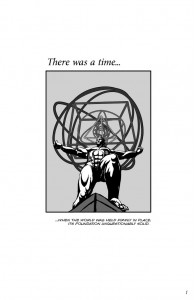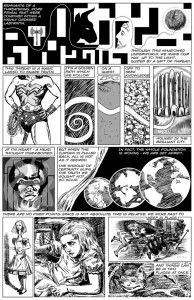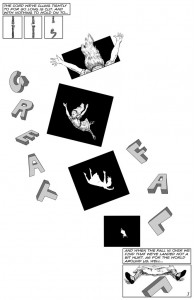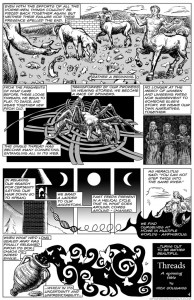With less than two months to go, I’m eagerly counting down to March 9 and the release of my comics dissertation-turned book Unflattening – see more details on Harvard University Press’s site here! (And if you can’t wait, I see it’s up for preorder at places like Amazon, Barnes&Noble, and Powells!)
-
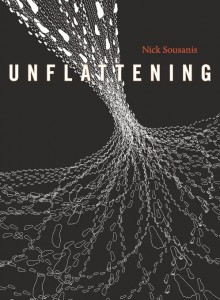
In the meantime, an essay I made in comics form before the dissertation is now in print in the Journal of Curriculum and Pedagogy’s special issue on Arts-Based Educational Research (Vol. 11, Iss. 2). The piece was originally created for my advisor Ruth Vinz’s course Postmodern Textual Practices (and shared on my site here), and it examines the move from modernism to postmodernism as constructed from mashups of mythology and fairy tales alongside the philosophical and scientific through the methodology of DJ sampling. Alongside Mind the Gaps the Shape of Our Thoughts, and Learning Pathways, Threads proved instrumental in shaping my dissertation process – particularly in moving back and forth between whole page compositions and intense panel-construction. This piece also touches on my Spin/Weave/Cut from which my site takes its name (see more on the meaning behind that here). You can view the piece in the journal online here and for those without University journal access, the first 50 to click through this link, can download the PDF of the article for free here. Or you can just read it on my site here and now…
Due to the diversity of sources woven into this piece, I thought it would be fun and perhaps helpful to show my hand a bit by providing the equivalent to footnotes to some of the imagery and references. So if you’re interested in looking behind the curtain, check it out below the comic itself. Wishing all a possibility-filled and expansive 2015. – Nick
What follows is not offered as explanation, but a key to some of the imagery referenced – if you’re so inclined to look behind the curtain. I advise reading only after you’ve read the comic.
Threads – the Key
Page 1: The opening line is my take on “once upon a time…” The image specifically references Lee Lawrie’s statue of Atlas at Lincoln Center. The “world” is partially a reference to the statue itself but also to Kepler’s sketch of the nested Platonic solids.
Page 2:
Panel 1: Greek myths are full of stories of locking away the primal, irrational, and chaotic in Tartarus (as with the Titans) or as this panel references – in the Labyrinth. I pull some of my thinking here from Michael Ayrton’s “Maze Maker,” a novel about the creative process, as told through the story of Daedalus, the builder of the labyrinth and father of Icarus. The Minotaur is seen less as a monster in its own right but as some primal aspect of ourselves necessary to keep down in order to seek a more rational life. Theseus follows Ariadne’s thread up into the light, and my text also alludes to Plato’s story of the cave and escaping to enlightenment (here, the radiating ball of string.)
P2-5: Ariadne’s thread becomes Wonder Woman’s lasso of truth, which in turn transforms into the Yellow Brick Road as a golden path toward truth and knowledge. This series of connections on threads served as the genesis for this piece.
P6: The text is a reference to Descartes’ separation of mind and body.
P7: Continental Drift Theory had a huge impact on how we think of the world and I sought to depict that here with images of earth as Pangae, Gondwana, and today’s configuration of the continents. (Also placing them as I did is also a reference to the way multiple earths are depicted in DC Comics’ “Crisis on Infinite Earths.”)
P8-11: “No fixed points in space” is a quote from Einstein picked up by Merce Cunningham as part of his approach to dance. Moving fast to keep in place is a nearly direct quote from Through the Looking Glass. The Cheshire Cat is joined with Schrodinger’s cat – and the idea of superposition. This would’ve been fun to explore more, and Alice’s cat playing with a ball of string almost made its way in (only the string stayed in back up at Panel 1.)
Page 3:
When the cord is cut, literally, I wanted to show our perspective falling like Alice down the Rabbit Hole. The fall not only references Alice’s fall, but the Great Fall text leads into Humpty Dumpty’s fall, which we’ll see the effects of on the next page.
Page 4:
Panel 1: Arriving on the scene to fix up Humpty Dumpty after his fall from the wall, are all the King’s Horse-Men. Having already decided to use hybrid creatures in the piece (a Spider-woman and a Mermaid), this compression of all the King’s horses and all the King’s men into one centaur worked well. Furthermore, I mashed this story with the Four Horsemen of the apocalypse, whose appearance here isn’t a fearful ending but something else altogether.
P2: Given the theme of threads that emerged early in creating this piece, Arachne was one of the few players I had in mind from the beginning. (Spiderman stayed out of it…) I saw Athena’s punishment as a gift instead, one of a number of reversals of perspective in the piece. “Fabric of relations” comes from Lyotard’s text on the Postmodern Condition. The image draws on Gustav Dore’s rendering of Arachne in Dante’s Purgatorio.
P3: We see the Three Fates, the Grey Women, or Moirae – maiden, matron, and crone. Those who spin, measure, and cut the thread that is our lives. Depending on where you read – their sight is ambiguous. Destiny or fate is often seen as blind, so while some accounts say that they share one eye between them, I went with the blind depiction here. (In subsequent pieces where I’ve incorporated them, I’ve gone with a different interpretation.)
P4: Rapunzel lets down her hair – a braid of DNA connecting us to our past, as postmodern methods cut up samples of past works to make new. The cycle of the moon also references the symbolism for the Three Fates – waxing, full, and waning, as the DNA becomes a coiled spiral, becomes waves – tides caused by the moon above. The text borrows heavily from Ayrton’s Maze Maker: “Life is not a circle but a helix.”
P5: Heraclitus’ words connect to the panel previous of past feeding present and the final panel on Chaos, as the Little Mermaid speaks to the merged creatures we’ve become, necessary for a world that’s constantly shifting.
P6: As this developed, it turned out for the most part I was working with stories featuring women – even when Theseus is depicted, it’s Ariadne that saves the day. Keeping with that, I brought in Pandora who definitely got a bad rap as patriarchal cultures took hold. Pandora’s name properly translated means “all-giving” and the “box” is actually a mis-translation for something more akin to a jar. I used the image of a jar and hoped by referencing “box” in the text that the connection was clear. I wanted to connect what’s in the jar/box back to things locked away in the Labyrinth, and in taking a different look at Pandora, take a different look at Chaos theory as well. And so what comes out is the fluid, nonlinear stuff that makes this world, and butterflies – symbols of metamorphosis and the butterfly effect – “a sensitive dependence on initial conditions.” Even the smallest of things can have an effect in a connected system. I think it’s a beautiful thought, and from the physics referenced by Alice to Chaos theory here, all of the narrative speaks to a world shrugging off a search for certainty and perhaps embracing complexity as complexity. And perhaps by undertaking this tapestry of ideas in visual form, it allows that complexity to stay present. (Thus you probably shouldn’t have read this.) – Nick



